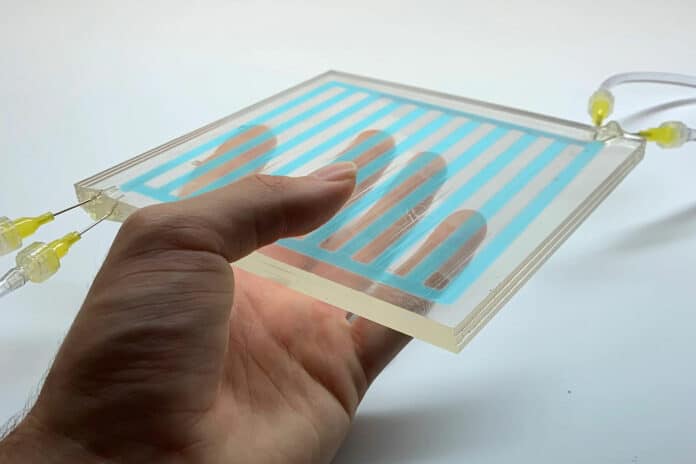Buildings use a ton of energy to heat, cool, and light the indoor environment as exterior conditions change. Designing building facades that can achieve versatile climate control directly could significantly reduce this energy footprint.
Currently, certain ‘smart’ building technologies are already available such as automatic blinds or electrochromic windows – which change their opacity in response to an electric current. But these systems are limited – they cannot discriminate between different wavelengths of light, nor can they control how that light gets distributed spatially.
Now, a team of researchers at the University of Toronto – led by Prof. Ben Hatton – have developed a multi-layered fluidic system that can reduce the energy costs of heating, cooling, and lighting buildings by optimizing the wavelength, intensity, and dispersion of light transmitted through windows.
The platform is inspired by the dynamic color-changing skin of organisms such as squid, cuttlefish, and krill. It offers much greater control than existing technologies while keeping costs low through the use of simple, off-the-shelf components.
The prototype “liquid window” incorporates multiple stacked sheets of transparent plastic that are permeated with an array of millimeter-thick channels through which fluids can be pumped. Customized pigments, particles, or other molecules can be mixed into the fluids to control what kind of light gets through – such as visible vs. near-infrared wavelengths – and in which direction this light is then distributed.
These sheets can be combined in a multi-layer stack, with each layer responsible for a different type of optical function: controlling the intensity, filtering the wavelength, or tuning the scattering of transmitted light indoors. The liquid window system can optimize light transmission by using small, digitally-controlled pumps to add or remove fluids from each layer.
Using computer models based on the physical properties of each prototype, the scientists were able to analyze the potential energy impact of covering a hypothetical building in this type of dynamic facade. The team also simulated various control algorithms for activating or deactivating the layers in response to changing ambient conditions.
“If we had just one layer that focuses on modulating the transmission of near-infrared light – so not even touching the visible part of the spectrum – we find that we could save about 25% annually on heating, cooling, and lighting energy over a static baseline,” says recent graduate Raphael Kay, lead author on a new paper. “If we have two layers, infrared and visible, it’s more like 50%. These are very significant savings.”
“Buildings use a ton of energy to heat, cool, and illuminate the spaces inside them,” says Kay. “If we can strategically control the amount, type, and direction of solar energy that enters our buildings, we can massively reduce the amount of work that we ask heaters, coolers, and lights to do.”
Journal reference:
- Raphael Kay, J. Alstan Jakubiec, Charlie Katrycz, and Benjamin D. Hatton. Multilayered optofluidics for sustainable buildings. PNAS, 2023; DOI: 10.1073/pnas.2210351120
